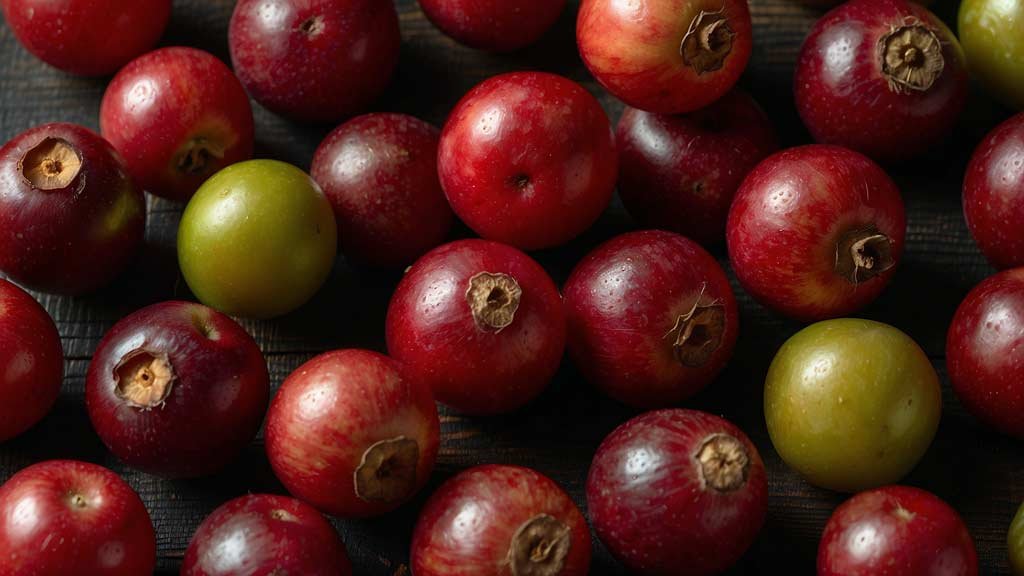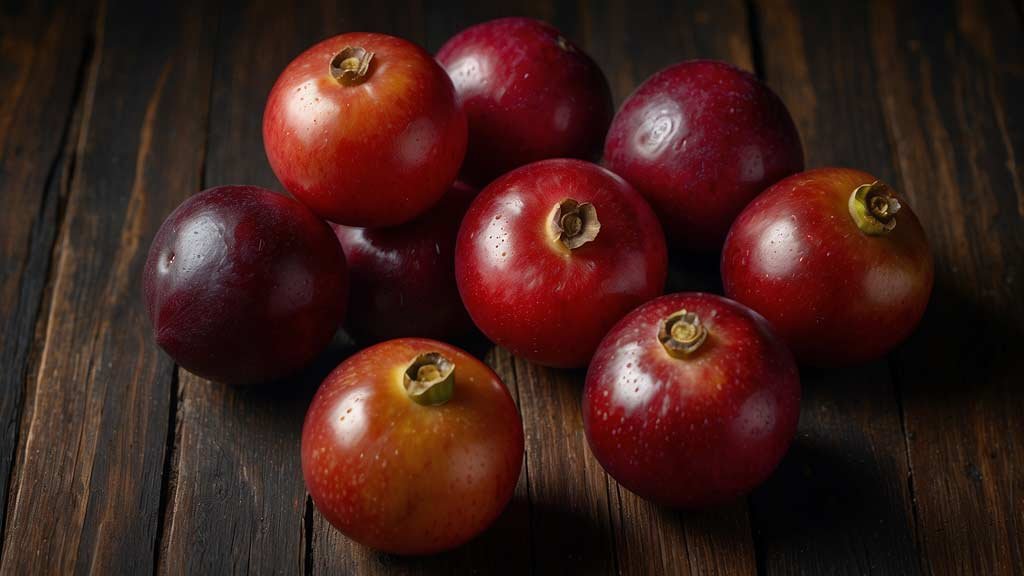A Tiny Berry with a Big Personality
The first time you see a camu camu berry, you probably wouldn’t guess it could change how you think about vitamin C. Small, reddish-purple, and often tucked away in the swampy floodplains of the Amazon, this berry isn’t much to look at. Locals have used it for generations, plucking it from canoes while navigating the tangled waterways of Peru and Brazil. The taste? Tart. Think of biting into a lemon but dial up the sharpness a notch. Most people can’t eat it straight without puckering up like they’ve chewed on a green persimmon. But that sour kick hides one of the densest natural sources of vitamin C on the planet.
And that’s where camu camu earns its reputation. When people talk about immune support, they often picture oranges or kiwis. But camu camu makes those fruits look like underachievers. In some measurements, it’s packed with up to 60 times more vitamin C than an orange. That’s not marketing hype; it’s science.
Table of Contents
Why Vitamin C Still Matters
It’s easy to shrug off vitamin C as old news. After all, sailors solved scurvy hundreds of years ago. But vitamin C isn’t just about preventing bleeding gums and fatigue. It acts as a cofactor in collagen production, helps repair tissues, and supports the immune system’s front-line defenses.
When viruses and bacteria enter your body, immune cells scramble to neutralize the threat. They need fuel, and vitamin C is part of that arsenal. It accumulates in white blood cells, enhancing their ability to fight off invaders. Without enough of it, your defenses lag, and healing slows down.
Now, could you technically get enough vitamin C from a balanced diet of bell peppers, citrus, and broccoli? Sure. But here’s the thing: most people don’t. Stress, smoking, pollution, even chronic low-level inflammation—all of these burn through vitamin C faster than you realize. That’s where camu camu berry shines: it delivers a concentrated dose in one small serving.
More Than Just Vitamin C
It’s tempting to reduce camu camu to a vitamin C pill in fruit form, but that sells it short. The berry also contains polyphenols, flavonoids, and carotenoids that contribute to its antioxidant punch. These compounds don’t just protect your immune system—they help calm oxidative stress throughout your body.
Oxidative stress is the wear and tear that happens when unstable molecules—free radicals—run amok. They damage cells, proteins, even DNA. Over time, this contributes to everything from aging skin to chronic disease. Antioxidants are like a cleanup crew, neutralizing the free radicals before they wreak havoc.
Camu camu seems particularly good at this. Studies suggest it can lower markers of oxidative stress after just a few weeks of use. Some research even shows it may support cardiovascular health by reducing blood pressure and improving cholesterol ratios.
A Flavor That Divides
Here’s the honest truth: you probably won’t be eating camu camu by the handful like blueberries. Its natural acidity is intense. Indigenous people often mix the pulp into drinks, sauces, or preserves, balancing that sour tang with sugar or honey. Today, most of us encounter camu camu in powdered form, freeze-dried and concentrated.
A teaspoon stirred into a smoothie provides a hefty vitamin C boost without overwhelming the palate. Add it to yogurt, oatmeal, or even homemade energy bars, and you won’t notice the sharpness much. Some people actually enjoy its tangy bite, describing it as a natural pick-me-up.
But beware of products that strip away the berry’s integrity. Not all camu camu powders are equal. Some are diluted, overly processed, or sourced from questionable suppliers. If you want the real benefits, look for organic, wild-harvested options with lab testing for vitamin C content.
Immune Support in the Real World
It’s one thing to rattle off lab numbers. It’s another to see how camu camu fits into daily life. Picture cold season, when everyone at the office is coughing and tissues pile up on desks. You can’t completely avoid exposure, but you can strengthen your defenses. Adding camu camu to your morning smoothie isn’t a magic shield, but it may shorten the duration of a cold or make symptoms less severe.
Parents sometimes sneak it into their kids’ juice or applesauce as a natural immune boost. Athletes use it to recover faster from grueling workouts since vitamin C helps reduce inflammation and muscle damage. Even skin enthusiasts have started using camu camu extracts in serums, banking on its ability to brighten and support collagen.

Traditional Wisdom Meets Modern Research
Long before nutritionists measured milligrams of vitamin C, Amazonian communities valued camu camu as medicine and food. Elders would prepare it for fever, infections, or even as a general tonic to restore strength. That traditional knowledge is now colliding with modern science, and the results are lining up.
One clinical study compared camu camu juice to straight vitamin C tablets. Both groups consumed similar amounts of vitamin C, but only the camu camu group showed significant reductions in oxidative stress and inflammation. That suggests there’s more going on here than just the vitamin itself—the synergy of compounds in the whole fruit seems to matter.
Potential Mood Benefits
There’s also an intriguing angle about camu camu and mood. Emerging research hints that its antioxidants and phytochemicals may support brain health, reducing symptoms of stress and depression. It’s too early to call it a natural antidepressant, but it makes sense. Chronic inflammation and oxidative stress often underlie mood disorders, and anything that calms that storm could help stabilize the mind.
Some people anecdotally report feeling more balanced and energized when they take camu camu regularly. Whether that’s placebo or not, the berry seems to be doing something beyond immune support.
How to Use Camu Camu Berry
If you’re curious to try it, here are some easy ways:
- Smoothies: Blend a teaspoon of powder with banana, spinach, and almond milk.
- Juices: Mix into orange or pineapple juice for a supercharged drink.
- Baked Goods: Add to muffins, pancakes, or energy bars for a tangy twist.
- Supplements: Capsules work if you can’t handle the flavor or want convenience.
Start small. The high vitamin C content means you don’t need much. Overdo it, and you may end up with digestive upset.
Quality and Sustainability
Camu camu’s popularity is rising fast, and that brings both opportunity and risk. On the positive side, demand creates economic incentives for Amazonian communities. Harvesting camu camu can be sustainable, especially when the berries are gathered wild from riverside shrubs rather than clear-cut plantations.
The risk is overharvesting and monocropping. If the global market treats camu camu like quinoa or acai, we could see ecosystems stressed and indigenous traditions disrupted. Choosing products that are fair-trade and sustainably harvested isn’t just a feel-good move—it helps preserve the berry’s future.
Side Effects and Considerations
Nothing is perfect. Too much vitamin C can cause stomach cramps, diarrhea, and kidney stone risk in sensitive people. Camu camu powder is potent, so moderation matters. Pregnant or breastfeeding women should check with their doctor before supplementing, as should anyone with chronic health conditions.
If you’re on blood pressure medication or chemotherapy drugs, be cautious. High antioxidant intake can sometimes interfere with treatment efficacy. The berry may be natural, but it’s still powerful.
Final Thoughts
Camu camu berry is one of those rare plants that makes you rethink what nutrition looks like in the natural world. A fruit so small, growing in the flooded Amazon, yet carrying enough vitamin C to put supermarket oranges to shame. It’s tart, it’s powerful, and it deserves a place in the conversation about immune health.
But maybe the bigger lesson here is that health doesn’t come from one fruit alone. It comes from the combination of habits, foods, and choices you make every day. Camu camu is a tool—a sharp, bright one—but still just a tool. Pair it with sleep, exercise, good food, and less stress, and then you’ll see its true potential.
Article Sources
At AncientHerbsWisdom, our content relies on reputable sources, including peer-reviewed studies, to substantiate the information presented in our articles. Our primary objective is to ensure our content is thoroughly fact-checked, maintaining a commitment to accuracy, reliability, and trustworthiness.
- Inoue, T., Komoda, H., Uchida, T., & Node, K. (2008). Tropical fruit camu-camu (Myrciaria dubia) has anti-oxidative and anti-inflammatory properties compared to vitamin C tablets. Journal of Nutritional Science and Vitaminology, 54(6), 458-464. https://pubmed.ncbi.nlm.nih.gov/18922386/
- Langley, P. C., & others. (2015). Antioxidant and associated capabilities of camu camu (Myrciaria dubia): A systematic review. Journal of Alternative and Complementary Medicine. PMC. https://www.ncbi.nlm.nih.gov/pmc/articles/PMC4296744/
- Maqsood, S., et al. (2025). Nutritional Composition, Pharmacological Properties, and Health Effects of Camu-Camu Fruit (Myrciaria dubia). Food Science & Nutrition.
https://onlinelibrary.wiley.com/doi/full/10.1002/fsn3.70331 - Do, N. Q., et al. (2021). Anti-Allergic Effects of Myrciaria dubia (Camu-Camu) Fruit Extract. Antioxidants, 11(1). https://www.mdpi.com/2076-3921/11/1/104
- Healthline. (2019, March 20). 7 Evidence-Based Health Benefits of Camu Camu. Healthline. https://www.healthline.com/nutrition/camu-camu
- WebMD. (n.d.). Camu Camu — Uses, Side Effects, and More. WebMD.
https://www.webmd.com/vitamins/ai/ingredientmono-1243/camu-camu - Medical News Today. (2021, November 29). Camu camu: Health benefits, risks, and how to eat. Medical News Today. https://www.medicalnewstoday.com/articles/camu-camu

